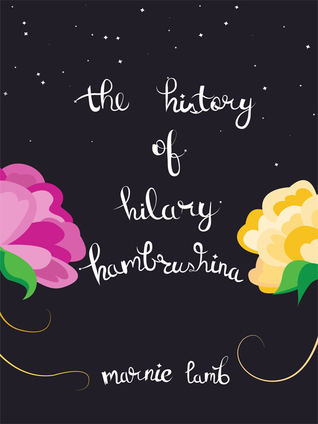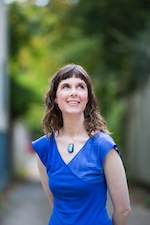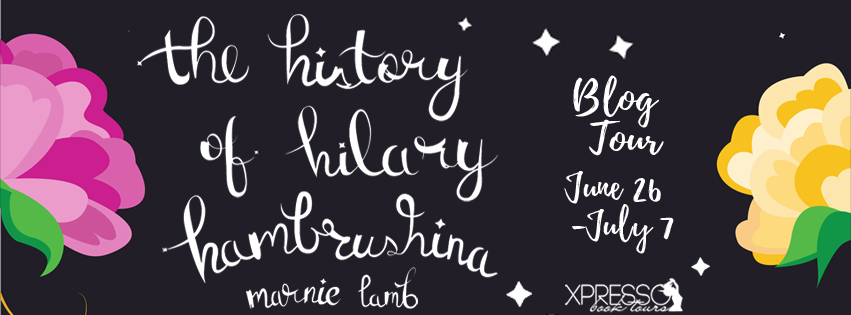
The History of Hilary Hambrushina
Marnie Lamb
Publication date: May 31st 2017
Genres: Contemporary, Young Adult
Hilary has one goal for her first year in junior high: to become popular. But her plans are turned upside down when her best friend leaves for the summer and a quirky girl named Kallie moves in next door. Kallie paints constellations on her ceiling, sleeps in a hammock, and enacts fantastical plays in front of cute boys on the beach. Yet despite Kallie’s lack of interest in being -cool, – Hilary and Kallie find themselves becoming friends. That summer friendship, however, is put to the test when school begins, reigniting Hilary’s obsession with climbing the social ladder. As Hilary discovers the dark side to popularity, she must decide who she wants to be before she loses everything.
Excerpt:
It arrives on a Tuesday
afternoon. A white square envelope with the words “M. Lamb, Author” written in
a hand that resembles Matura font. I slit the square using my mackerel-shaped
envelope opener. Inside is a white card with the texture of linen. Unfolding
it, I read, “Dear Marnie, Your TARDIS awaits you at Yonge-Dundas Square. Sincerely,
the Cover Contessa.”
The following morning, I take the subway
to the square, a central gathering place between the Eaton Centre and Ryerson University
in downtown Toronto. I walk across the pavement, not entirely sure where I’m
heading. I flick my eyes to one edge of their sockets and then the other, back
and forth, trying to remain alert without being conspicuous. Then I spot it: a
black booth eight feet high on the southeast corner. As I approach the booth,
my throat begins pulsing. This is my first time in a TARDIS. Will someone try
to stop me or demand to see a permit before letting me pass? But no one is
watching me. In fact, I seem to be invisible, judging from the lack of eye
contact that passersby offer.
The TARDIS looks like a narrow garden
shed. I don’t see a doorknob or handle, so I place my hand in the centre and
the doors slide open. The second my body is fully inside, they shut.
I blink, adjusting my eyes from the
harshness of the bright summer sun to the softness of the forty-watt incandescent
bulbs. The décor is ornate and feminine but discreet: black-and-white wallpaper
with tiny polka-dots and an oval-shaped mirror with silver edges in a curlicue
pattern. In a wall shelf under the mirror is a pitcher of pink lemonade and a
plate of Nanaimo Bars. “Thank you,” I say, to whoever thought to cater to my
culinary needs.
Two black easy chairs sit opposite the
doors. Opposite the shelf is a piece of paper enclosed in plastic and mounted
on the wall. I pour myself a glass of lemonade, choose a bar, and sit in the chair
next to the paper. That’s when I notice the keypads: one containing numbers,
the other letters.
The paper lists a set of instructions: “You
may use the TARDIS only once to travel to your chosen destination. When you re-enter
the TARDIS, you will automatically be transported back to the same location from
which you left. You will return one minute after you departed. You may bring
one other person with you.” The TARDIS doesn’t contain any note-taking device,
so I’m happy I brought a notepad and pencil case with me.
As I sip the sweet tartness of the
lemonade and recline into the chair, my body is calm but my mind is already
racing to and fro, tossing around multiple possibilities. The first ones are
practical. Some of my newer short stories, still in development, are set in the
past. Choosing accurate details—the sounds, smells, tastes, touches, and sights
of a particular time—is essential to me when writing. I could go to suburban
Ottawa in the 1970s to witness the racial and gender tensions that play out
among the housewives and their husbands and children. Or farther back, to
Winnipeg in the 1960s so that I could see the modelling school my mother
attended. Surely, I should choose one of those destinations, to serve my
immediate need.
But I recall Virginia Woolf’s challenge
for writers to discover the lives of girls and women from the past. How did
they structure their days? What did they do for fun? What did they talk about
in private with one another or in their journals? Surely, enough details about
the 1970s and 1960s exist: in books and archival documents, on the Internet, in
my mother’s memory. Why squander my one chance to get that five, ten,
twenty-five, whatever the percentage is that hasn’t been preserved?
No, I should choose somewhere more
distant, someplace for which the finer details have been lost. Renaissance
England to witness the first performance of
Twelfth Night at the Inns of Court or The
Tempest at Whitehall Palace. The Heian period in Japan to spend time with
the royal ladies, help them dress in rainbow layers of robes, and listen to
them recite poetry in the moon room of the castle. Babylon to stroll in the
hanging gardens, sniff the flowers, and observe the animals that make their
home there. Ancient Egypt to watch the building of Giza and see the original
cat mummies.
And yet, these stories have been told by
others. They’re grand but not personal. So perhaps I should visit my ancestors,
the fishermen, watchmakers, greengrocers, and teachers of Norfolk and Tyrone. I
recall the genealogical research I did as a teenager with my father, all those
birth certificates dated suspiciously soon after the marriage certificates. Who
were these women? Details exist in archives and novels about the lives of some
middle- or lower middle–class women, but not about those of the Lamb, Nockels, Stewart,
and McKeown women. And then there’s my mother’s maternal ancestry, in Poland,
about which I know nothing. Or to investigate her paternal ancestry, I could go
to Manitoba in the 1850s to discover whether the rumour of my having a tiny
drop of Métis blood is true.
My fingers flit over the alphabetical
keypad. To postpone one decision, I turn to the empty seat, press my hand into
the soft fabric, and am confronted with another. A single travelling companion.
My mother or father, who would love to witness our shared heritage? My brother,
who has a passion for all kinds of travel? A trusted friend, on whose memory I
will rely for some details upon our return? I start to think that one decision
depends on the other, but then I realize. Writing, at least in its early
stages, has always been a solitary endeavour for me. And I don’t want the
choice of or desire for a particular companion to influence the choice of
destination. It’s up to me.
Whichever path I choose, I’ll wonder and
ruminate about the roads not taken. But I have to get on with it. Even though
I’ll be gone only one minute, I feel that I’m wasting time. There’s so much to
be done. I need to make a decision.
I emit a ragged sigh. “Help.”
And then I know. Nazareth in the 30s. The
house of Martha and Mary. The weeks leading up to Jesus’s visit. What did their
food taste like? What did the fabric of their clothes feel like? What did they
talk and think about? What was their schedule? Martha’s schedule, anyway. That
flake Mary probably spent most of her time mooning at the feet of any hot young
friend that Lazarus brought home. Poor Martha, the unglamorous labourer whose efforts
were ungratefully dismissed by the Son of God. You can’t live by bread alone. Fine
but remember the final word: we still need bread. And somebody had to bake that
bread and sweep the floors to ensure that Jesus didn’t get tetanus from
stepping on a rusty nail.
I drain my lemonade, inhale, and press in
the destination and time. Martha’s story, that’s what I seek. Will the seeds I
gather blossom into a novel, a short story, or a single poem? I won’t know
until I’ve returned and begin cultivating them, but the form doesn’t matter as
long as the details and voice are authentic. Yes, Martha, it’s time for the
working women, for those of us who quietly and industriously plug away, without
due applause, who feed the bellies of our leaders and make the world run
smoothly, to be spotlighted. It’s time to lift the veil into your private time,
to see what you did and felt after Jesus left, and to complicate your image and
problematize the dichotomy set up between you and your sister.
I’m already halfway there.

Author Bio:
A Journey Prize nominee, Marnie Lamb earned a master’s degree in creative writing from the University of Windsor. Her short stories have appeared in various Canadian literary journals. Her first novel, a YA book named The History of Hilary Hambrushina, is forthcoming from Iguana Books. When she is not writing fiction or running her freelance editing business, she can be found cooking recipes with eggplant or scouting out colourful fashions at the One of a Kind Show.



I really like the cover of this book. It would make such a pretty journal.
ReplyDelete